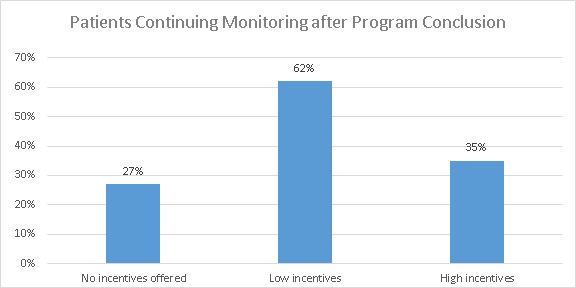
Health Monitoring Lottery Has Lasting Rewards
Organization : Center for Health Incentives and Behavioral Economics
Project Overview
Project Summary
Researchers enrolled patients in a daily lottery in which they could win an expected value of $1.40 or $2.80. Patients who won the lottery could only collect the reward if they had used their monitors the previous day. Patients who won the lottery, but had not used their monitors the previous day, were informed that they would have received a reward had they followed their regimen.
Impact
A daily lottery incentive with an expected value of $1.40 per day improved adherence to self-monitoring regimens in patients with poor diabetes control by 23 percentage points, from 58% to 81%. This improvement continued even after the incentive was removed. A higher daily lottery incentive worth $2.80 also led to a 19 percentage point increase in adherence rates during the trial period, but the effect did not last once the incentives were removed.
Source
Source
Challenge
Wireless devices have made the task of monitoring one’s health easier than ever. These devices are especially cost-effective for those with chronic conditions, but that doesn’t guarantee that patients will use them regularly. Finding ways to ensure that patients remain engaged and stick to their self-monitoring regimens is crucial for improving health outcomes.
Design
Patients with poor diabetes control were given three devices that they were instructed to use once daily: a glucometer to measure blood sugar levels, a digital blood pressure monitor, and a digital scale to measure their weight. The readings from each device were automatically transmitted to a website, which allowed participants to monitor their measurements online.
Some patients were then randomly selected to participate in a lottery-based incentive scheme with an expected reward value of either $1.40 or $2.80. Participants in the incentive groups who used their three devices on a given day were entered into a lottery for a financial incentive on the following day. All patients in the incentive groups received a daily text message, email, or both (depending on their preference), informing them of the morning’s winning lottery number. Participants who had a winning number and adhered to their self-monitoring regimen were also informed of their reward. Participants who won but had not adhered to their regimen received a notification that they would have gotten the reward had they used their devices on the previous day.
Impact

A randomized evaluation found that during the 3-month intervention period, patients in both the low and high incentive groups showed improved adherence to their self-monitoring regimens, maintaining use rates of about 81% and 77% respectively compared to 58% among patients who were not offered any incentives. Although adherence decreased in both incentive groups after the lottery ended, participants in the low incentive group still showed significantly higher self-monitoring rates than patients who were not offered any incentives (62% versus 27%).
Implementation Guidelines
Inspired to implement this design in your own work? Here are some things to think about before you get started:
- Are the behavioral drivers to the problem you are trying to solve similar to the ones described in the challenge section of this project?
- Is it feasible to adapt the design to address your problem?
- Could there be structural barriers at play that might keep the design from having the desired effect?
- Finally, we encourage you to make sure you monitor, test and take steps to iterate on designs often when either adapting them to a new context or scaling up to make sure they’re effective.
Additionally, consider the following insights from the design’s researcher:
- Creating frequent lotteries with the opportunity to win a reward can improve patient engagement and adherence to care regimens.
- For lotteries with a relatively low reward range (e.g. $1.40-2.80), the structure of the incentive itself may be more important than the precise amount during the intervention period.
- Finding an appropriate reward amount is important for maintaining improved adherence rates after the intervention period. Smaller rewards may be more effective than higher rewards at sustaining adherence even after the incentives are removed. Patients who receive larger rewards may feel as though they are motivated by the payment itself, rather than the health benefits, to improve their adherence.
- Notifying the individuals who failed to follow their regimen, yet would have won the lottery, can activate a feeling of regret and motivate patients to better monitor their health in the future.
Project Credits
Researchers:
Aditi P. Sen Contact The Wharton School of the University of Pennsylvania; Penn CMU Roybal P30 Center in Behavioral Economics and Health and Leonard Davis Institute Center for Health Incentives and Behavioral Economics
Taylor B. Sewell The Wharton School of the University of Pennsylvania; Perelman School of Medicine at the University of Pennsylvania
E. Brooks Riley Perelman School of Medicine at the University of Pennsylvania
Beth Stearman Abramson Cancer Center of the University of Pennsylvania; Penn CMU Roybal P30 Center in Behavioral Economics and Health and Leonard Davis Institute Center for Health Incentives and Behavioral Economics
Scarlett L. Bellamy Perelman School of Medicine at the University of Pennsylvania
Michelle F. Hu Perelman School of Medicine at the University of Pennsylvania
Yuanyuan Tao Perelman School of Medicine at the University of Pennsylvania; Penn CMU Roybal P30 Center in Behavioral Economics and Health and Leonard Davis Institute Center for Health Incentives and Behavioral Economics
Jingsan Zhu Perelman School of Medicine at the University of Pennsylvania; Penn CMU Roybal P30 Center in Behavioral Economics and Health and Leonard Davis Institute Center for Health Incentives and Behavioral Economics
James D. Park Perelman School of Medicine at the University of Pennsylvania; Rutgers, Robert Wood Johnson Medical School
George Loewenstein Carnegie Mellon University; Penn CMU Roybal P30 Center in Behavioral Economics and Health and Leonard Davis Institute Center for Health Incentives and Behavioral Economics
David A. Asch The Wharton School of the University of Pennsylvania; Perelman School of Medicine at the University of Pennsylvania; Center for Health Equity Research and Promotion, Philadelphia Veterans Affairs Medical Center; Penn CMU Roybal P30 Center in Behavioral Economics and Health and Leonard Davis Institute Center for Health Incentives and Behavioral Economics


